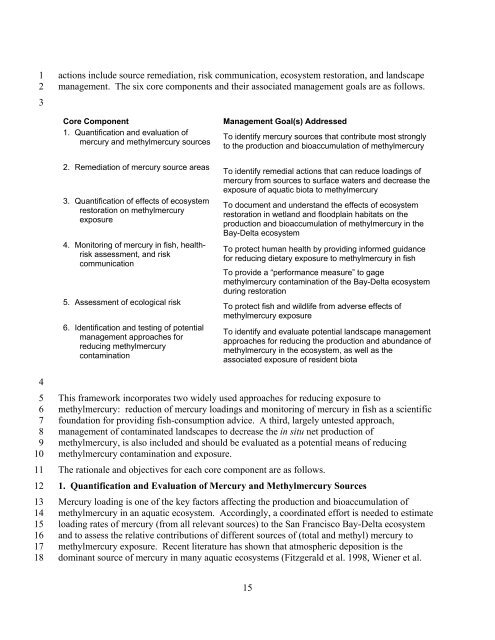Mercury Strategy for the Bay-Delta Ecosystem - CALFED Bay-Delta ...
Mercury Strategy for the Bay-Delta Ecosystem - CALFED Bay-Delta ...
Mercury Strategy for the Bay-Delta Ecosystem - CALFED Bay-Delta ...
Create successful ePaper yourself
Turn your PDF publications into a flip-book with our unique Google optimized e-Paper software.
1<br />
2<br />
3<br />
4<br />
5<br />
6<br />
7<br />
8<br />
9<br />
10<br />
11<br />
12<br />
13<br />
14<br />
15<br />
16<br />
17<br />
18<br />
actions include source remediation, risk communication, ecosystem restoration, and landscape<br />
management. The six core components and <strong>the</strong>ir associated management goals are as follows.<br />
Core Component Management Goal(s) Addressed<br />
1. Quantification and evaluation of<br />
mercury and methylmercury sources<br />
2. Remediation of mercury source areas<br />
3. Quantification of effects of ecosystem<br />
restoration on methylmercury<br />
exposure<br />
4. Monitoring of mercury in fish, healthrisk<br />
assessment, and risk<br />
communication<br />
5. Assessment of ecological risk<br />
6. Identification and testing of potential<br />
management approaches <strong>for</strong><br />
reducing methylmercury<br />
contamination<br />
To identify mercury sources that contribute most strongly<br />
to <strong>the</strong> production and bioaccumulation of methylmercury<br />
To identify remedial actions that can reduce loadings of<br />
mercury from sources to surface waters and decrease <strong>the</strong><br />
exposure of aquatic biota to methylmercury<br />
To document and understand <strong>the</strong> effects of ecosystem<br />
restoration in wetland and floodplain habitats on <strong>the</strong><br />
production and bioaccumulation of methylmercury in <strong>the</strong><br />
<strong>Bay</strong>-<strong>Delta</strong> ecosystem<br />
To protect human health by providing in<strong>for</strong>med guidance<br />
<strong>for</strong> reducing dietary exposure to methylmercury in fish<br />
To provide a “per<strong>for</strong>mance measure” to gage<br />
methylmercury contamination of <strong>the</strong> <strong>Bay</strong>-<strong>Delta</strong> ecosystem<br />
during restoration<br />
To protect fish and wildlife from adverse effects of<br />
methylmercury exposure<br />
To identify and evaluate potential landscape management<br />
approaches <strong>for</strong> reducing <strong>the</strong> production and abundance of<br />
methylmercury in <strong>the</strong> ecosystem, as well as <strong>the</strong><br />
associated exposure of resident biota<br />
This framework incorporates two widely used approaches <strong>for</strong> reducing exposure to<br />
methylmercury: reduction of mercury loadings and monitoring of mercury in fish as a scientific<br />
foundation <strong>for</strong> providing fish-consumption advice. A third, largely untested approach,<br />
management of contaminated landscapes to decrease <strong>the</strong> in situ net production of<br />
methylmercury, is also included and should be evaluated as a potential means of reducing<br />
methylmercury contamination and exposure.<br />
The rationale and objectives <strong>for</strong> each core component are as follows.<br />
1. Quantification and Evaluation of <strong>Mercury</strong> and Methylmercury Sources<br />
<strong>Mercury</strong> loading is one of <strong>the</strong> key factors affecting <strong>the</strong> production and bioaccumulation of<br />
methylmercury in an aquatic ecosystem. Accordingly, a coordinated ef<strong>for</strong>t is needed to estimate<br />
loading rates of mercury (from all relevant sources) to <strong>the</strong> San Francisco <strong>Bay</strong>-<strong>Delta</strong> ecosystem<br />
and to assess <strong>the</strong> relative contributions of different sources of (total and methyl) mercury to<br />
methylmercury exposure. Recent literature has shown that atmospheric deposition is <strong>the</strong><br />
dominant source of mercury in many aquatic ecosystems (Fitzgerald et al. 1998, Wiener et al.<br />
15

















